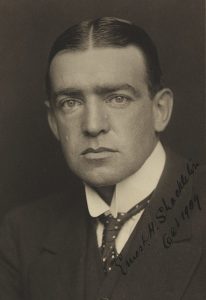Sir Ernest Henry Shackleton (1874–1922)
 Ernest Shackleton was one of the most celebrated explorers of the Heroic Age. He led the 1907-09 Nimrod Antarctic expedition, which pioneered a route to the South Pole and reached latitude 88° 23′. His return to Antarctica in 1914 was intended to achieve the first trans-Antarctic crossing, but instead resulted in a dramatic story of disaster, shipwreck and survival. He died in South Georgia at the start of his final expedition in 1922.
Ernest Shackleton was one of the most celebrated explorers of the Heroic Age. He led the 1907-09 Nimrod Antarctic expedition, which pioneered a route to the South Pole and reached latitude 88° 23′. His return to Antarctica in 1914 was intended to achieve the first trans-Antarctic crossing, but instead resulted in a dramatic story of disaster, shipwreck and survival. He died in South Georgia at the start of his final expedition in 1922.
Discovery Expedition (1901–1903)
Shackleton came from an Anglo-Irish family, and began a career in the British merchant navy. He was then recruited to join Robert Scott’s two-year Discovery Expedition and, with Scott and Edward Wilson, achieved a pioneering 93-day sledge journey across the Ross Ice Shelf towards the South Pole, a total of 957 miles (1540 km). However, Shackleton suffered on that expedition, and Scott decided to send him home, unwillingly, after the first season.
Nimrod Expedition (1907–1909)
Back at home in England, Shackleton married his fiancé Emily Dorman, and the first two of their three children were born. But Shackleton was now inspired by the idea of Antarctic exploration, and began plans for his own expedition to the continent and the South Pole. In 1907 he set off with his newly acquired ship Nimrod, dogs, ponies, a motor car and a strong team of men, including Professor Edgeworth David, Douglas Mawson, Frank Wild and Tom Crean. Among the many achievements of this remarkable expedition were the first ascent of Mount Erebus and the reaching of the South Magnetic Pole, but most famous is his sledge journey towards the South Pole.
Leaving their winter quarters on October 29, 1908, they crossed the Ross Ice shelf, passing Scott’s furthest south of 82°16½‘ S, and found a route onto the Antarctic Plateau via a glacier which he named Beardmore Glacier in honor of his main sponsor. This would be the route that Scott would follow on his later South Pole expedition of 1911/12. Shackleton pressed on towards the Pole with his companions Jameson Adams, Frank Wild and Eric Marshall, but on January 9, 1908 at 88°23‘ S he decided to turn back, only 97 nautical miles (180 km) from the Pole, to ensure the safe return of the party. “Whatever regrets may be, we have done our best.” Shackleton wrote. Amundsen was to remember that moment on his own southward journey:
“We did not pass that spot without according our highest tribute to the man who – together with his gallant companions – had planted his country’s flag so infinitely nearer the goal than any of his predecessors. Sir Ernest Shackleton’s name will always be written in the annals of Antarctic exploration with letters of fire.”
Endurance Expedition (1914–1917)
On his return to Britain, Shackleton was awarded his knighthood for his ground-breaking achievements on the Nimrod Expedition. He had demonstrated that the South Pole was attainable, and he always hoped to return to the continent to complete his conquest of the Pole. Early 1912, however, the news came that Amundsen and, later, Scott had claimed that prize. The final goal left for Shackleton was to attempt the first trans-Antarctic crossing from coast to coast; and so the Imperial Trans-Antarctic Expedition was born.
The Endurance left England at the outbreak of the Great War in August 1914, with many dogs, the ship’s cat, and a crew ultimately of 28. The aim was to land the sledging party on the Weddell Sea coast from where they would cross entirely unknown territory to the South Pole, and thence to the Ross Sea. Another ship, the Aurora, left Australia, with instructions to lay depots for the final leg of the sledge crossing. But heavy sea ice prevented Shackleton from making landfall as he wished and after nine months beset in the ice, the ship succumbed to the pressure of the ice, and was sunk in the Weddell Sea.
The 28 men survived on the ice for a further five months, until a desperate open boat journey found them at Elephant Island, a remote and desolate island in the South Shetlands. Shackleton and five companions then made an extraordinary open boat journey to South Georgia, followed by the first crossing of the mountainous island to Grytviken, where they received help from astonished whalers. Every man on Elephant Island was eventually rescued. Although the original goal was not achieved, the aptly-named Endurance Expedition has become legendary in exploration history.
Quest Expedition (1921-1922)
After the war, Shackleton, and indeed many of his fellow expeditioners, continued to be irresistibly drawn to Antarctica. His final expedition, this time on board the Quest, lacked defined objectives and on arriving at Grytviken in South Georgia, Shackleton died of ill-health on January 22, 1922. He is buried in the whalers’ graveyard on the island, and today his grave is visited by thousands for whom the name of Ernest Shackleton is synonymous with the Heroic Age of exploration.





